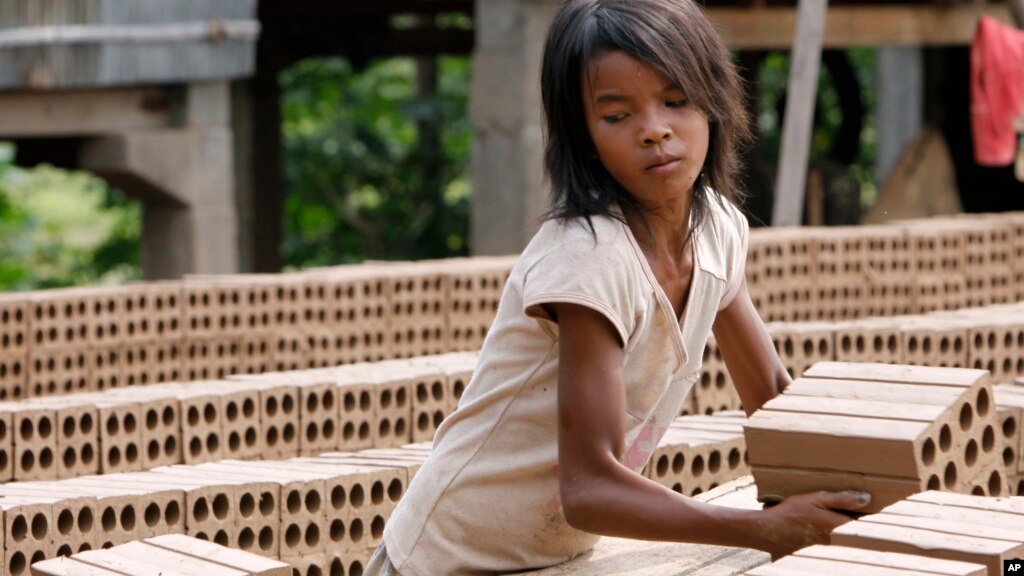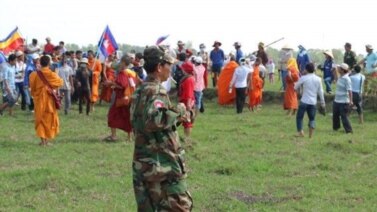
Earlier this year, a United Nations report found that 10 percent of Cambodian children between the ages of seven and 14 are working. That is one of the highest rates in Southeast Asia. The report said one in four Cambodians aged 7 to 14 are forced to drop out of school to help their families. UN officials say the child labor rate in Cambodia has dropped over the past 10 years. But the country has a lot more to do to keep a greater number of children in school.
One story begins at a factory in Cambodia. The factory manufactures bricks for building projects.
Outside the building, 15-year-old Pheap and her mother, Chrup, are turning pieces of dirt. Pheap has worked at the factory for one year. She was taken out of school after two years to support her father, who was sick. Some of the money she earned went to her 10-year-old sister and baby brother.
Pheap and her mother each earn $80 a month. They work 8 hours a day, seven days a week. Pheap says working in the factory helps her mother provide for their family. It also helps support her brother and sister.
About 430,000 Cambodians under 18 years-of-age are employed. Half of them work in what the International Labor Organization calls the worst forms of child labor. They include agriculture, salt production, housework, fishing and brick-making.
Veng Heang is Director of the Child Labor Department in Cambodia. He says the number of child workers has been nearly cut in half since 1999. He says the country wants to lower that number to 375,000 by the end of the year.
“Not only in 2015, but after 2015 – we have to work very carefully on quality of education, food security, and especially income generation for the poor.”
Targeting areas like agriculture and fisheries has helped reduce the number of child laborers. In the future, making sure Cambodian children stay in school will be important.
World Vision is a non-profit group. It seeks to reduce child labor by offering assistance for both education and for household livelihoods. The group operates a four-year project called EXCEL. The project receives financial support from the U.S. Department of Labor.
World Vision says its EXCEL program in Cambodia has already helped 20,000 children. The group's Imelda Ochavillo says Cambodians are becoming less tolerant of child labor. But she says more is needed to solve this complex issue.
“If you want to reduce it significantly we should have very comprehensive interventions that would include continuous poverty alleviation, provision of alternative sources of income, decent employment for youth, and education should be made accessible.”
She says child labor is usually not a major issue for children under age 12. Most remain in their villages and attend school. But it is between the ages of 12 and 17 that child labor becomes an issue.
Pheap dreams of finding a job in a clothing factory. That could double her wages. Her mother Chrup wants more for her, too. She says she does not want her daughter to work in the brick factory.
But a better future for Chrup’s family is far from guaranteed. The local school will not admit her other 10-year-old daughter. The girl is needed to look after her baby brother anyway. However, without an education, it is hard to find a way out of poverty.
I’m Mario Ritter.
Robert Charmichael reported this story for VOA from Phnom Penh. Mario Ritter adapted it for Learning English. George Grow was the editor.
Words in This Story
generation – n. the act of creating something; to produce a result
livelihood(s) – n. a way of earning money; making a living
tolerant – adj. willing to accept something or someone
alleviation – n. the process of lessening the effect of something; (often) to reduce something





